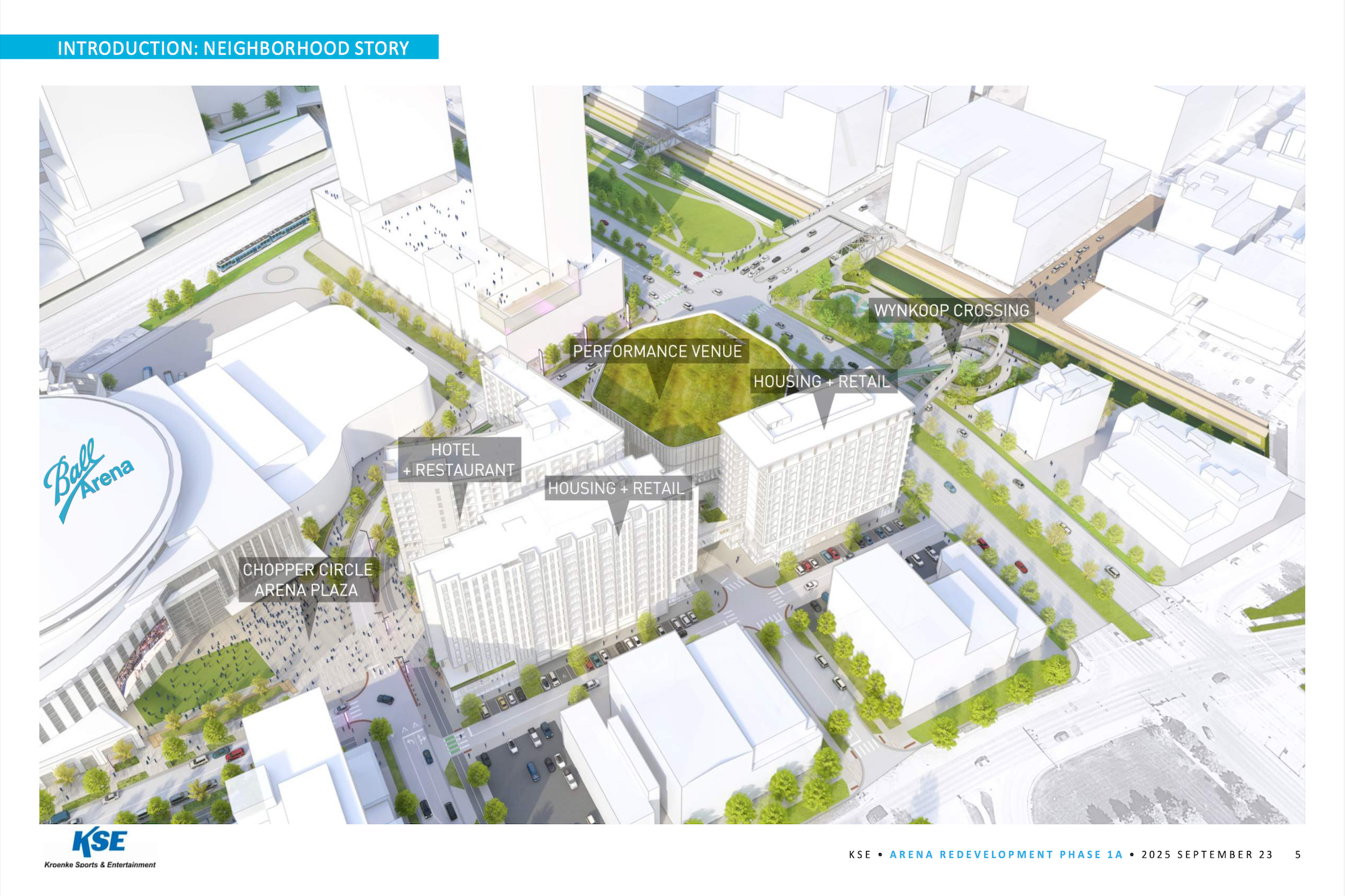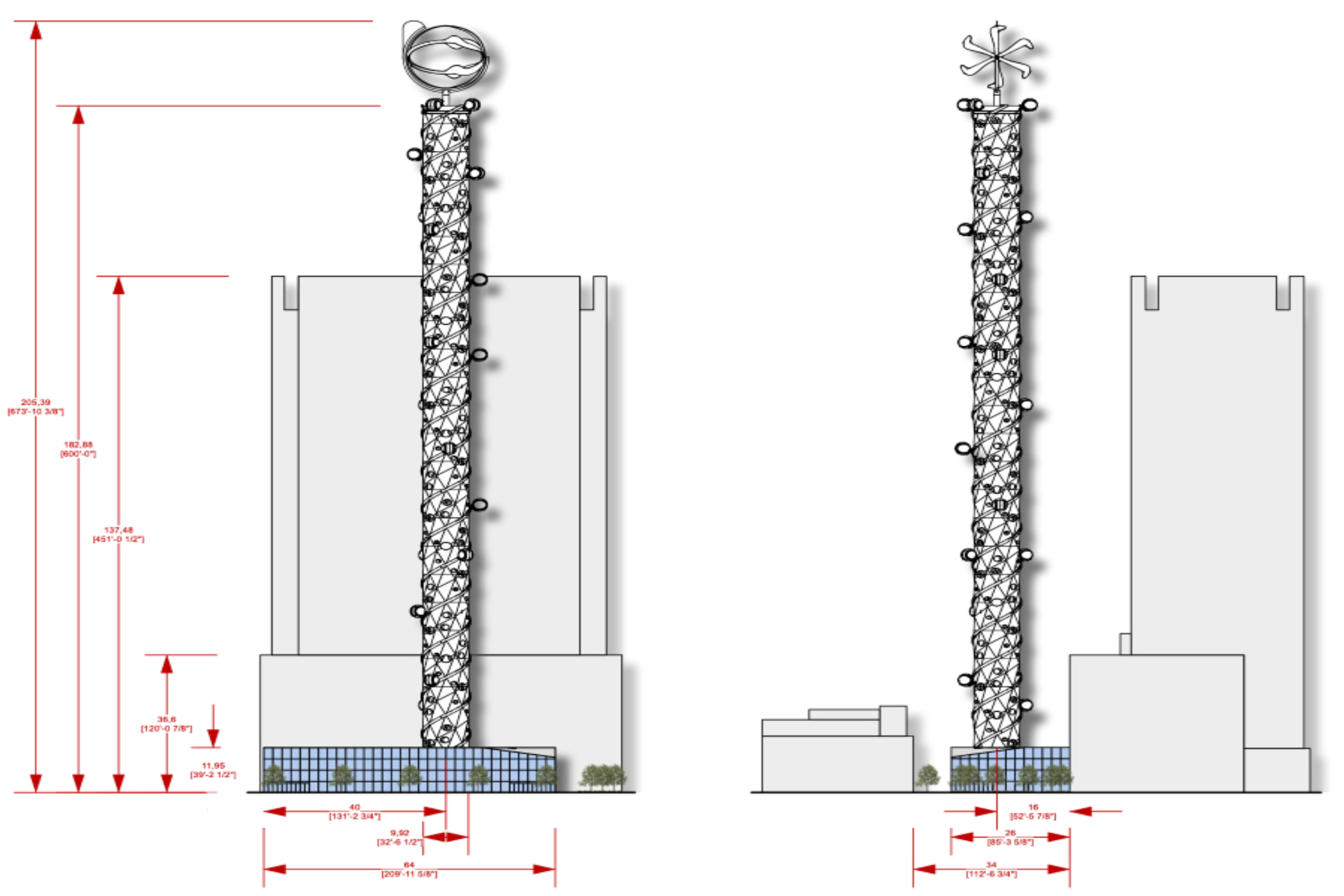Atlanta-based Portman Holdings is planning a $100 million mixed-use project in Downtown Denver’s Union Station district.
Portman’s proposed hotel and office development at the corner of 18th and Wewatta was announced this summer, but details and renderings of the project at that time were very limited, so DenverInfill waited until more information was available. Fortunately, that time has come.
Let’s begin by getting you oriented geographically. The project—known as Union Tower West—will share the block bounded by 18th, Wewatta, 19th, and Chestnut with the proposed 1975 18th Street housing project and Xcel Energy’s Denver Steam Plant. Below is a GoogleEarth aerial with the site outlined in yellow:
For a bird’s-eye view of the site, this drone-tastic image by Ryan Dravitz will do the trick:
The Union Tower West development includes a 180-room hotel and approximately 100,000 square feet of office space. The project also includes 216 parking spaces and a pedestrian plaza facing the 18th and Wewatta corner. All of the following images are courtesy of John Portman & Associates architects:
Here’s a preliminary concept rendering of project showing the main entry at the corner of 18th and Wewatta and the tower rising above:
The project’s different components are stacked vertically. The ground floor contains the office and hotel lobbies and meeting/dining spaces. Floors 2 through 4 are the parking levels (including bicycle parking and electric-car charging stations). Floors 5 through 8 feature the hotel rooms, and Floors 9 through 12 contain the office space. Here are two images that help illustrate the building program. The first shows a cutaway slice through the building parallel with 18th Street, and the second in a stacking diagram that shows the project’s four major components vertically:
According to a recent press release, Portman is hoping to break ground on Union Tower West by the end of 2014.
Special Bonus: Did you know that Xcel Energy’s downtown Denver steam system is the oldest continuously operated commercial district heating system in the world? It’s true!
The original steam plant at the corner of 19th and Wewatta (official address is 1875 Delgany Street) was built by the Denver City Steam Heating Company and began providing steam heat through underground pipes to downtown customers in 1880 (Denver was just 22 years old at the time!). The plant was entirely rebuilt in 1972, which is the gold-colored building you see there today. The Denver Steam Plant is the hub for a network of over 16 miles of underground steam pipes that service over 130 customers in the downtown Denver area including many of downtown’s largest office buildings and major cultural, government, and civic facilities. Needless to say, Xcel has no plans to relocate the Denver Steam Plant, and its continued presence in the booming Union Station area gives us a small but important reminder of the Central Platte Valley’s industrial heritage. For more information about the Denver Steam Plant, below are links to two documents I stumbled across on the internet from which I gleaned the above information:
Denver’s 128-Year-Old Steam System: The Best is Yet to Come, by the International District Energy Association, District Energy, Fourth Quarter 2008 (a general news article about the downtown Denver steam system).
Engineering Assessment – Denver District Steam System, by Public Service Company of Colorado Engineering and Construction, March 2013 (a technical report that includes a variety of historical, engineering, and financial information about the steam system).
















Great update! That’s interesting regarding the steam plant and it appears ready for increased usage in the coming years. However, aesthetically, the building is kind of an eyesore. And loud. Are there any plans to improve the look and sound of the building to make it blend with all the new development happening around it..?
I agree… this plant looks terrible, especially next to all the newer buildings going up. I sincerely hope that there is some sort of update planned for it.
I agree. I hope that Exel Energy has plans to at a minimum upgrade the exterior of this building so that is more pleasing to the eye considering all of the new construction going on within a 10 block radius. It will definitely be out of place once all of the current and planned construction is complete.
That there drone-tastic shot is pretty nifty. Shows a bunch of other neat things as well.
Nice updates.
Question: is anything happening with the two LARGE open lots on Market Street between 18th and 19th?
Why is it called Union Tower West? What is it west of, or is there a Union Tower East?
Also, Denver was 22 years old in 1880.
Hi Kevin,
I’m not sure about why they are calling it Union Tower West. I guess because it’s west of Union Station and it’s a tower? Also, thanks for the correction! For some reason, in my head late last night 1880 – 1958 = 12!
Just curious. I thought of the “west of Union Station” possibility but from your site aerial you posted, it’s actually due north and, since it’s between 18th and 19th while DUS is at 17th, most would regard it as being east of the station.
Yeah, it’s west only in that it’s across Wewatta Street from the historic station and assuming you subscribe to the convention that the named streets run “north” and “south.”
Yeah, I do not subscribe to that revisionist street history! From the time I came to Denver, although the downtown grid is a true 45-degree diagonal, it had always been held that the named streets ran eastbound and westbound, primarily because the main Larimer-Lawrence arterial pair was State highway 33, which ran east-west, and because the named streets for the most part led you into East Denver on the numbered avenues or into West Denver via the Larimer0Lawrence Viaduct (replaced by Walnut Street Viaduct/Auraria Parkway).
Meanwhile, the numbered streets fed into North Denver, so they were considered to be running north-south.
Even the Denver streets department, with its traffic count reports, had always reported NB or SB counts on the numbered streets and EB or WB counts on the named streets, until about 10 or so years ago, when I noticed an inconsistent change. Now if you look at traffic counts, sometimes Stout Street is reported as EB and sometimes as NB. I am a holdout for what it was traditionally called. So at Union Station, I always refer to the 1881 wing buildings at the east wing or west wing, which I believe is how the EIS referred to them as well.
It seems like there are an awful lot of hotels being built around downtown Denver. Do you know of anybody who has analyzed the amount of hotel rooms per square mile in Denver versus other cities? It just seems like we could benefit from more apartments and retail rather than hotels.
I have not seen an analysis on Denver’s hotel rooms compared to other cities, but you will frequently see articles about downtown’s high occupancy rate and lack of hotel rooms. I’m not sure about linking articles in the comments but there is a recent one (10/17/2014) in the DBJ about downtown setting hotel occupancy records this year.
I would agree that residential (specifically condos) and retail are both more important for downtown, but as long as they stay relatively full and put people on the streets I think there’s no harm in filling some of our empty blocks with hotels.
Denver used to be quite short on hotels.
Some cities have a lot more hotels than others — mainly a question of how large the tourist / business visitor trade is.
Denver used to have a number of hotels suitable for a city which nobody visits unless they have relatives there — which is *totally wrong* these days.
Have you seen any studies on the amount of new residential in Denver? It seems like there are a ton of new buildings…wondering if they will be filled?